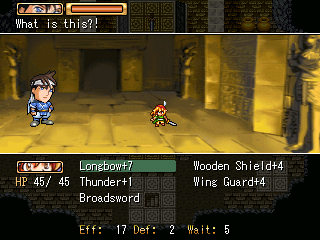Posted by: ![[personal profile]](https://rainbowgames.electricopolis.net/wp-content/uploads/2018/12/user-10.png) jackvambrace
jackvambrace

Wild Arms came out in 1997 (United States), about the same time Final Fantasy 7 did. FF7 had the legacy of all the other Final Fantasy games before it paired with awesome new technology, so Wild Arms just kinda got overshadowed.
At it’s core, Wild Arms is a JRPG, with special moves, random encounters and all that good stuff. Numbers! Swords! Tropes! What sets it apart from the others is presentation. The game strikes a pretty good balance of typical eastern rpg elements, anime, and a distinct wild west feel.

See?
Like many good rpgs, the cast is a key part of the experience. I really like how the characters are introduced and built up in this game, and the series as a whole. Each character is a Dream Chaser, a sort of professional wanderer. From the bottom left, Hanpan, wind mouse companion to Jack, Jack, the professional treasure hunter and swordsman, Rudy, the wandering youth, and Cecilia, the freshly graduated crest sorceress. At the start of the game you play through each character’s prologue. Playing with each character individually gives you insight into their backstory and motivations, as well as serving as a decent tutorial for how each character plays. Some games have a distinct protagonist followed along by a supporting cast of characters. Xenoblade is definitely Shulk’s story. Breath of Fire is Ryu’s. Wild Arms is all three character’s stories.
The music is really well done, this game definitely benefited from being released on a disc based system just for the music alone. The action segments get your blood pumping, the emotional bits tug at your heart, and the weirder dungeons sound positively alien. Outside of battles, everything uses 2d graphics, so there was only so much they could do to convey the mood of a scene. I remember being little, and sticking a tape recorder up to my tv because I wanted to just have the music to listen to.
The gameplay is that of your typical rpg, explore towns, explore dungeons, fight monsters. Each of your characters has a set of items at their disposal that allow you to interact with the world. You can get bombs to blow open doors, a lighter to set stuff on fire, Jack’s first item is just Hanpan, who can grab items and flip switches. The tool system reminds me a bit of Zelda and Metroid, especially in the sequels where you can find loot and bonus items by coming back to some areas later with new tools.
Battles don’t have much in the way of tricks that you have to pick up on, you just kinda hit the enemies till they go away. Each character has a pretty set class, you won’t be whacking anything with Cecelia, and Rudy has 0mp the entire game. Each character has different skills that shape how they contribute to battle.
Rudy has the titular ARMs, which are mostly firearm type weapons that have a set number of uses before needing to be reloaded. If you run out, you have to use a special item to reload them, or visit a specific shop to purchase ammunition. You can also upgrade the ARMs to improve their stats with money. Jack has Fast Draws, special sword techniques that consume MP. Fast Draws are learned at set points in the game, sometimes from events, sometimes from other Dream Chasers, a few are even learned from a boss. These can’t be upgraded like Rudy’s ARMs, but mp restoratives are much more common, and you can reduce the mp cost with an item. Cecilia has hands down one of my favorite magic systems in any game. Crest Sorcerers use a crest graph to store a set combination of magical crests, allowing them to use magic. They are reusable. She starts with cure and fire, and you can swap them out for any magic spell in the game. You want lightning and strength up at level 1? Done. Reflect and Revive? Done. A rampaging disco ball that does all eight elements of damage at once and speed up? Done and done. There is a high level shop that let’s you get stronger spells or spells that hit more enemies, but a lot of the low level stuff is still perfectly fine even on to end game.
Each character also has force abilities, which work kinda like your regular skills, but they run on fp instead. I think Lufia 2 had a similar system, where you get points for stuff happening in battle, and can use them for skills outside of mp based skills. These are pretty useful, gives you things like guaranteed critical hits, 100% accuracy, and group item use to name a few.
So far as the story goes, it’s pretty good. There are a few twists that are actually pretty neat, and there are some bits so obvious that you could call them in the first 20 minutes. There’s lots of silly, a bit of sad, and a few dashes of bitter. I don’t want to spoil anything, so I’ll just say it’s worth your time.
No game is without it’s flaws, this one included. The graphics are a little dated, everyone looks kinda like a bobble head during battle.

The script is a little more coherent than Wild Arms 2, but is less consistent with the rest of the series as a whole. This is the kind of game you probably want to play with a guide of some kind available, as you can get lost and there isn’t much in the way of direction sometimes. It’s also hard to find some of the bonus items and the secret dungeon. If these things are enough to put you off you might try the remake for ps2, Wild ARMs Alter Code F. I prefer the original release myself, but both are good.
Altogether this is a really good game that is very dear to me for a variety of reasons. I really liked it as a game, and a ton of other stuff that I found when I was younger came my way by virtue of looking up stuff on this series. I really hope someone sees this and tries it, cause I know maybe one person who had played it, and this game deserves so much more love than that. For anyone interested, it’s on sale for USD 1.80 on the Playstation Store until september 15. (I’m in the US, so prices may vary elsewhere)
![comment count unavailable]() comments
comments
Source: rainbowgames DW






















